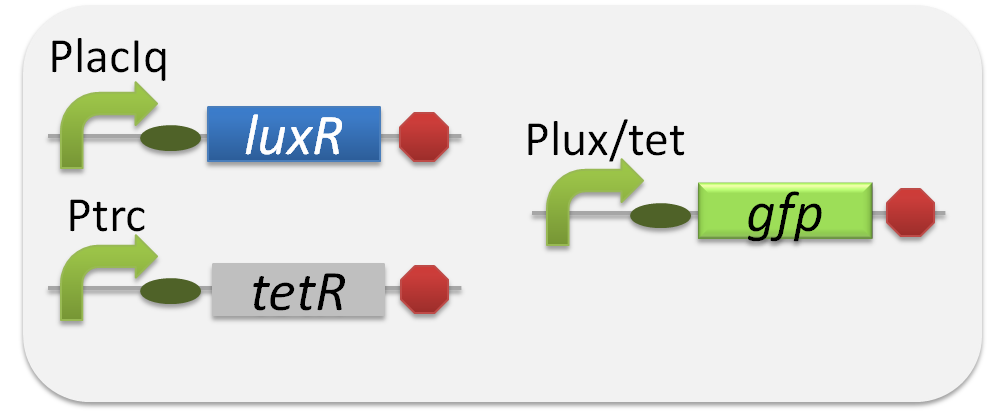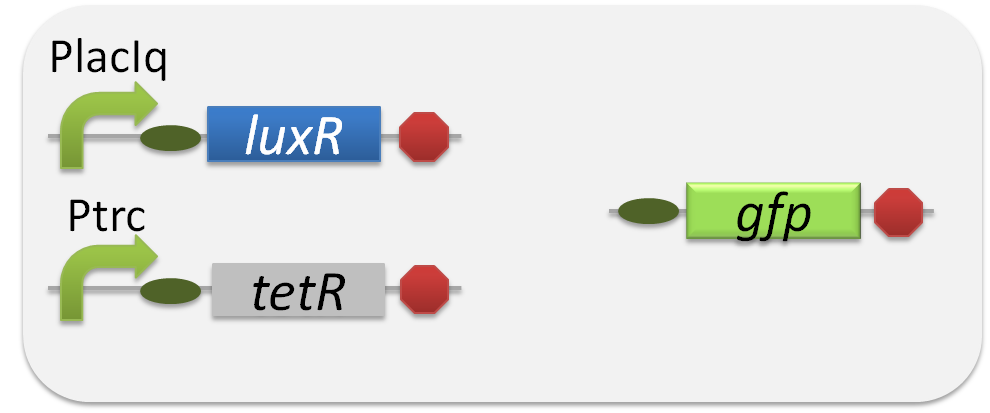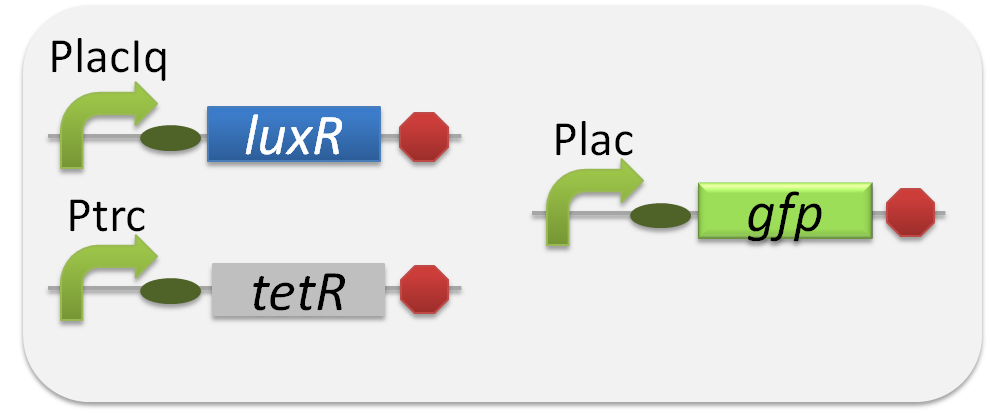Team:Tokyo Tech/Experiment/banddetect
From 2012.igem.org
(→Construction of lux/tet hybrid promoter) |
|||
| Line 10: | Line 10: | ||
<div id="tokyotech" style=" font:Arial ;left ; font-size: 15px; color: #000000; padding: 30px;"> | <div id="tokyotech" style=" font:Arial ;left ; font-size: 15px; color: #000000; padding: 30px;"> | ||
| - | + | For construction of the band detect system, we developed a new part lux/tet hybrid promoter ([http://partsregistry.org/wiki/index.php?title=Part:BBa_K934024 BBa_K934024]). The lux/tet hybrid promoter, which is composed of a LuxR operator and two TetR operators, activates the expression of the downstream gene only when LuxR-3OC6HSL complex exists and active TetR does not exist. To characterize the function of the lux/tet hybrid promoter, we constructed a part, Plux/tet-GFP ([http://partsregistry.org/wiki/index.php?title=Part:BBa_K934025 BBa_K934025]) by inserting the promoter in front of a GFP coding sequence. By using the reporter cell that contains Plux/tet-GFP and constitutive LuxR and TetR generator (PlacIq-LuxR-Ptrc-TetR), we measured the fluorescence intensity of the reporter cell. In the measurement, we confirmed the GFP expression under the four different combinations of two inducers, 3OC6HSL and aTc (anhydrous tetracycline). In the absence of the both inducers, the culture with lux-tet hybrid promoter-gfp showed the background–fluorescence intensity generated by promoterless-rbs-gfp on pSB3K3. The presence of either 3OC6HSL or aTc alone had little effect on increasing the fluorescence intensity. In the presence of both inducers, the culture showed about 500-fold higher fluorescence intensity than that in the absence of both inducers(Fig2-1-3-2-7). This result confirmed that the assembly of the LuxR operator and the two TetR operators integrated the inputs of 3OCH6HSL and aTc into the output of GFP transcription. | |
| - | For construction of the band detect system, we developed a new part lux/tet hybrid promoter ([http://partsregistry.org/wiki/index.php?title=Part:BBa_K934024 BBa_K934024]). The lux/tet hybrid promoter, which is composed of a LuxR operator and two TetR operators, activates the expression of the downstream gene only when LuxR-3OC6HSL complex exists and active TetR does not exist. To characterize the function of the lux/tet hybrid promoter, we constructed a part, Plux/tet-GFP ([http://partsregistry.org/wiki/index.php?title=Part:BBa_K934025 BBa_K934025]) by inserting the promoter in front of a GFP coding sequence. By using the reporter cell that contains Plux/tet-GFP and constitutive LuxR and TetR generator (PlacIq-LuxR-Ptrc-TetR), we measured the fluorescence intensity of the reporter cell. In the measurement, we confirmed the GFP expression under the four different combinations of two inducers, 3OC6HSL and aTc (anhydrous tetracycline). In the absence of the both inducers, the culture with lux-tet hybrid promoter-gfp showed the background–fluorescence intensity generated by promoterless-rbs-gfp on pSB3K3. The presence of either 3OC6HSL or aTc alone had little effect on increasing the fluorescence intensity. In the presence of both inducers, the culture showed about 500-fold higher fluorescence intensity than that in the absence of both inducers(Fig2-1-3-2-7). This result confirmed that the assembly of the LuxR operator and the two TetR operators integrated the inputs of 3OCH6HSL and aTc into the output of GFP transcription. [[https://2012.igem.org/Team:Tokyo_Tech/Projects/Lux-Tet_hybrid_promoter/index.htm#Materials_.26_Method Protocol]] | + | [[https://2012.igem.org/Team:Tokyo_Tech/Projects/Lux-Tet_hybrid_promoter/index.htm#Materials_.26_Method Protocol]] |
=Materials & Method= | =Materials & Method= | ||
Revision as of 22:56, 26 October 2012
Contents |
Construction of lux/tet hybrid promoter
For construction of the band detect system, we developed a new part lux/tet hybrid promoter ([http://partsregistry.org/wiki/index.php?title=Part:BBa_K934024 BBa_K934024]). The lux/tet hybrid promoter, which is composed of a LuxR operator and two TetR operators, activates the expression of the downstream gene only when LuxR-3OC6HSL complex exists and active TetR does not exist. To characterize the function of the lux/tet hybrid promoter, we constructed a part, Plux/tet-GFP ([http://partsregistry.org/wiki/index.php?title=Part:BBa_K934025 BBa_K934025]) by inserting the promoter in front of a GFP coding sequence. By using the reporter cell that contains Plux/tet-GFP and constitutive LuxR and TetR generator (PlacIq-LuxR-Ptrc-TetR), we measured the fluorescence intensity of the reporter cell. In the measurement, we confirmed the GFP expression under the four different combinations of two inducers, 3OC6HSL and aTc (anhydrous tetracycline). In the absence of the both inducers, the culture with lux-tet hybrid promoter-gfp showed the background–fluorescence intensity generated by promoterless-rbs-gfp on pSB3K3. The presence of either 3OC6HSL or aTc alone had little effect on increasing the fluorescence intensity. In the presence of both inducers, the culture showed about 500-fold higher fluorescence intensity than that in the absence of both inducers(Fig2-1-3-2-7). This result confirmed that the assembly of the LuxR operator and the two TetR operators integrated the inputs of 3OCH6HSL and aTc into the output of GFP transcription. [Protocol]
Materials & Method
[Go to the project page "Band detect system"]
Construction
To characterize lux/tet hybrid promoter ([http://partsregistry.org/wiki/index.php?title=Part:BBa_K934024 BBa_K934024]), we constructed Plux/tet-GFP ([http://partsregistry.org/wiki/index.php?title=Part:BBa_K934025 BBa_K934025]) by ligating the lux/tet hybrid promoter ([http://partsregistry.org/wiki/index.php?title=Part:BBa_K934024 BBa_K934024]) to the upstream of promoterless GFP generator ([http://partsregistry.org/wiki/index.php?title=Part:BBa_I13504 BBa_I13504]).
pSB3K3-PlacIq-LuxR-Ptrc-TetR / pSB6A1-Plux/tet-GFP (JM2.300)…Sample
pSB3K3-PlacIq-LuxR-Ptrc-TetR / pSB6A1-⊿P-GFP (JM2.300)…negative control
pSB3K3-PlacIq-LuxR-Ptrc-TetR / pSB6A1-Plac-GFP (JM2.300)…positive control
2.Strain
JM2.300
3.Protocol
1.1 Prepare overnight culture of reporter cell at 37°C for 12hours.
1.2 Take 30 μl of the overnight culture of reporter cells into LB (3 ml) + antibiotics (Amp 50 μg/ml + Kan 30 μg/ml). (→fresh culture)
1.3 Dilute the flesh culture in 1:50 by the following conditions:
A) LB
B) LB + aTc (500 ng/ ml)
C) LB + 3OC6HSL (1 μM )
D) LB + aTc (500 ng/ml) + 3OC6HSL (1 μM )
1.4 Incubate the fresh culture of diluted inducer cell for 2 hours.
1.5 Flow cytometer measurements for GFP expression of reporter cell.
[Go to the project page "Lux-Tet hybrid promoter assay"] "
"


